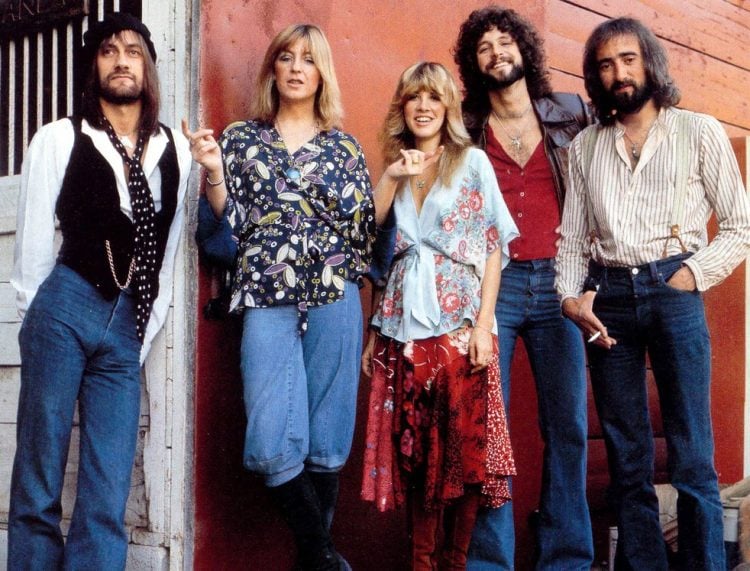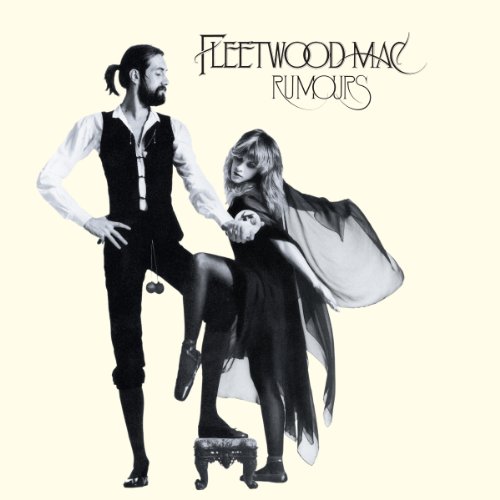Early Fleetwood Mac: Looking back to the ’60s
By James Rooney – Cumberland Times (Cumberland, MD) December 21, 1969
New York — Unless you’re really following the music scene, chances are good you haven’t heard of — or heard, for that matter — the Fleetwood Mac.
They sing blues, among other things, and in a recent poll, they scored as the fourth most popular group in England right behind the Beatles, Rolling Stones and Jethro Tull. Well, that’s where the Beatles started, too.
It helps to see as well as to hear the Fleetwood Mac — to watch, for example, Peter Green bending over his guitar, carefully choosing the notes of his hauntingly beautiful song, “Albatross.”
Flanking Peter one recent night at New York’s Fillmore East were the four other members of the group, all working with equal concentration to achieve the melting poetic charm of the instrumental.

Fleetwood Mac: Light show background
Glowing on a screen in back of them was a formless mass of gently shimmering light and color which suggested a Monet painting.
A few moments before, the energy and power of their music had the crowd screaming. Now they were calm. A trance-like serenity gripped the audience.
Green, the leader of the group, professes to hate musical labels, but in an interview, he conceded that the Fleetwood Mac was primarily a blues group.
In answer to the inevitable question as to whether an Englishman can successfully sing authentic blues, he responded, “Yes and no. In one sense, only blacks can do it, because it’s a black musical form. But to me, blues means something sad. We don’t try to imitate black men, but we do follow their style.”
The Fleetwood Mac feel they have something unique to contribute to the blues form. “We play however we want, and do not flow in a particular vein. It all comes out as one band, but a lot of different things go into it,” Green said.

Fleetwood Mac’s distinctive sound
Part of the distinctiveness of their sound can be attributed to the rarity of having three lead guitars rather than the customary one. Both Green and Danny Kirwan have a similar guitar style which stresses elaboration on a basic progression, while Jeremy Spencer seems to be more into the elemental power of 1950s rock.
Concerning their influences, Peter remarked, “We had no success until we developed our own bit. It was not a conscious thing, but as soon as we stopped trying to imitate we picked up fans.”
Their three albums trace their progression and evolution. The earliest, “Fleetwood Mac,” betrays a heavy emphasis on simple, direct and powerful blues. “English Rose,” their second, is a patchwork of various unrelated tracks from different English albums. The third, “Then Play On,” is rich in musical diversity, although still broadly blues.
The purpose of their music is in harmony with the traditional aims of blues. Peter said that his music comes from “my feelings and my experiences. It brings out emotions and conveys how bad things are. In this sense, I’m not interested so much in music as such, but in truth.”
As befits his seriousness he spoke at length about how he strives “not to waste words.” For this reason, he likes classical symphonies. Because of their meticulous choice of notes, what the classical musician said 100 years ago is still valid today.
The purpose of his music is “to try to show all that I feel. It’s all I can do in my own way to protest.” His evocative hard blues are testimony to his dissatisfaction with the way things are today.
Video: Fleetwood Mac “Oh Well” performed live (1969)

Fleetwood Mac gets it together
By Kathie Staska and George Mangrum – The Argus (Fremont, California) February 27, 1976
One of the hottest bands in the country, and one of the tightest bands in the world, is Fleetwood Mac. This band has been making great music for eight years, and is just now gaining the recognition that it so greatly deserves.
The musicians have gone through many changes the last few years, and at the same time, they have always come off on stage and record very clean and professional while putting forth a good sound.
Although a lot of their earlier fans think that the original guitarist Peter Green was the best thing that ever happened to Fleetwood Mac, the truth of the matter is that the band is hotter now than ever before.
“I think our fans have stayed with us, pretty much, and we have picked up a lot of followers,” said the leader of the group, drummer Mick Fleetwood, who is one of the two original members of Fleetwood Mac, that is still with the band, along with bassist John McVie.
The current hit album
The band is riding high on its current smash album “Fleetwood Mac,” which is a top 10 nationwide hit that climbs higher in the charts every week. The LP has already gone gold and is on the brink of going platinum. The record stores can not keep it in stock as it goes out as fast as it comes in.
For the last year, the band has been working very hard either traveling or recording whenever they can. Their November gig at Winterland could not have gone any better.
Bob Welch, who was the band’s lead guitarist since 1971, left the group about a year ago to form his own band, Paris.
Taking his place is Lindsey Buckingham on guitar and vocals. The same time he came to the band, so did his vocal partner, the very pretty Stevie Nicks. They had an album on Polydor a few years back under a duo entitled Buckingham Nicks.
“The two things that stood out to me my first year with Fleetwood Mac were the two shows we did for Bill Graham,” said Stevie in a recent interview at the Record Plant in Sausalito. “The show we did outdoors at the Oakland Coliseum was great. The band played well and the bill was great with Peter Frampton and Dave Mason and a few others.
“The Winterland show was a lot tighter as a band. We had been together longer and things seem to jell. Each outing for Graham we try harder it seems because he tries so hard.”
“We are looking forward to playing for Bill again on April 25 at the Oakland Coliseum with Peter Frampton and Gary Wright. We really enjoyed last summer’s show ,and this outdoor event should be a good one also. It will be our second gig of that current tour.”
A long way since the 1960s
The two Americans in the band have made a great difference to the band’s sound. The group has come a long way since their bluesy rock days in the late ’60s.
They are more versatile and, in person, more wide-open rock and roll. Their style is so unique no band can copy them. Lindsey and Stevie bring a fresh bright sound to the experience and poise of Fleetwood.
John and Christine McVie began with the band as Christine Perfect in 1970. She plays electric piano and owns one of the most popular voices in rock music today. She came to Fleetwood Mac from Chicken Shack.
Buckingham tells about his first album with Fleetwood Mac, “I enjoyed doing the album very much. It was a very learning experience for me, especially working with Mick and John, because they have worked together for so many years. Their experience has helped me a lot.
“One thing that has been in all Fleetwood Mac albums is that great rhythm section. In the days of Peter Green and Bob Welch, the most consistent thing was Mick and John.
“That is something Stevie and I always had trouble with. Finding someone who could give us the energy we needed.”
“One of the reasons I think that we had so much success with our last album is that we approach our music from a free spirit,” says Stevie.
“Now in the band there are three writers and all three write differently. There is a cohesiveness that was not there before.”
Is the second album coming easier for the new duo in the band?
“No, it is coming harder,” comments Stevie, “it is just a lot of technical problems. The piano keeps going out of tune and things like that. It is hard on the momentum of the band when things like that happen.”
“It definitely has a lot to do with the momentum when you get to the studio at 2 pm and just hang around until 11 pm and you can’t get things together.”
The group as a whole thinks its second album as a unit is going to be more together than the first, but still resemble the previous effort.

Fleetwood Mac’s history and legacy
From the day Fleetwood Mac started gigging, they had a following, because folks in England remembered Green as the lead guitarist of the Bluesbreakers, and as a replacement for Eric Clapton. Mick and John had a following right from the start, also.
But Fleetwood Mac has had its ups and downs like almost every band has. A major setback came in 1974 when the band’s former manager had a falling out with the group, and decided to put his own band out under the name of Fleetwood Mac. This really caused a few headaches for Mick and the group, and put them back eight months.
Mick talks about those days, although he would like to forget that experience.
“For one reason or another, I’m the one in the band who kind of keeps a tap on things. To work at something that you really care about for seven years and then see it blow up in your face is really hard.”
“For eight months we could not play and what was going through our minds was that this thing we had worked hard at for so many years was falling apart in front of our eyes and we said they are not going to take it away from us.
“A guitarist we had at the time and me had a falling out over a lady and we just could not go on anymore. So we took the band off a major tour.”
“So the manager thought that the band must be breaking up and the manager decided that he was going to continue without us.”
Fleetwood Mac has gone from a time in ’74 when it looked as though the band was on its last legs, until ’75 when it became one of the country’s better and more successful bands.
Fleetwood Mac: Rock’s red-hot group (1977)
By Andrew Frances – Daily Breeze (Torrance, CA) October 30, 1977
They’ve just broken the all-time chart record for their album ‘Rumours,’ and are about to tour the country.
One of the longest-standing records in music history was broken last month. The title had belonged to the king of rock himself, the late Elvis Presley: 20 weeks at the No. 1 spot for his album Blue Hawaii.
Ten years after Elvis’s triumph and 21 weeks after their album became No. 1, the title went to a group named Fleetwood Mac. Their chart-topping album, which has already sold more than four million copies, is called ‘Rumours’.
The band dates back over 10 years, but numerous personnel changes had made the group the revolving door of rock, leaving them without an identifiable sound.

Last year, though, thanks to the addition of two Americans (guitarist Lindsay Buckingham and sensuous singer Stevie Nicks) to the original British core of Mick Fleetwood (drums) and John and Christine McVie (bass and keyboards respectively), Fleetwood Mac have finally managed to achieve their promise and have sold more than eight million albums over the past 18 months.
Their concert tours are now stadium sellouts, and, to crown it all, they garnered the three top honors (Best Album, Best Group and Rock Personalities of the Year) on TV’s Rock Awards.
Mick Fleetwood, the group’s founder, is also their manager, handling everyday professional responsibilities. It was Mick who approached John McVie to start Fleetwood Mac. John had recently learned to play bass “by taking the two top strings of a Hohner (six-string) guitar and playing bass on that.”
He had originally wanted to be a trumpeter. Though completely confident about his music now, John does not compose for the group and still feels “a little scared sometimes — you look up and say, ‘All these people — for us?'”
His wife, born Christine Perfect (“I was Perfect until I married John,” she quips), was originally an art teacher, occasionally doing window design on London’s fashionable Oxford Street. Her parents had to force her to learn piano because she hated it.
Now, though, she has written three giant hits for the band (“Over My Head”, “Say You Love Me” and “Don’t Stop”), and her sultry glow is confident and powerful, yet provocatively vulnerable.

The group’s new-found accessibility also seems to owe a lot to last year’s additions.
Lindsay Buckingham, a guitarist of extreme technical expertise, combines a gut-level feel for music with an atomic-energy source for expressing himself. His guitar solo rips regularly through the middle of his contribution to the ‘Rumours’ album, the scorching hit, “(You Can) Go Your Own Way.”
Then there’s blond-shagged vocalist Stevie Nicks, who, as the center spotlight’s closest friend, is often a swirl of chiffon portraying the dreamy Welsh witch Rhiannon from the hit song she wrote for the band earlier this year. “My songs are a rolling diary,” she says. “I’m a storyteller. I add a little, or take away.”
For Stevie, it began in high school. “I fell madly in love with this guy. Then he went to Mexico and I fell totally apart. I just sat down and wrote a song. It was terribly sad, terribly emotional. It was a bummer, but it was a beginning.”
“Rumours” and the preceding album, “Fleetwood Mac,” also recorded with the current lineup, have an energy and enthusiasm unmatched in rock. The songs on these albums have distinguished the new group not only from their earlier incarnations but also from every other band.
Talking about their phenomenal year, Stevie explains, “I think audiences really like us as people; I think they have a good feeling towards us in a human way.”
Soon Fleetwood Mac again will be crisscrossing the country on tour. We can only guess at the direction the group will take. Says Christine: “We never seem to stop progressing. Once you slot yourself, there’s only so far you can go in any one tight direction. I don’t want to stop experimenting, especially now that we have a combination of people who are able to do so many things so well.”
“We can’t really say where we’re going,” says Lindsay, “because ideawise, we’re always a little ahead of ourselves, which is the best creative situation to be in.”
How can you argue with that?




















